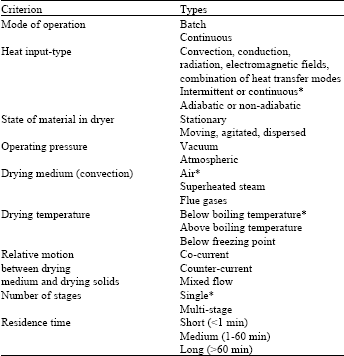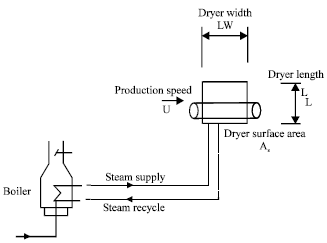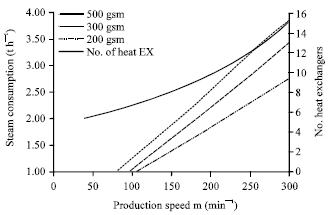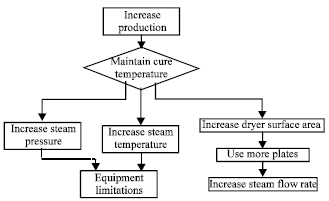Research Article
Microwave Processing Applications in Chemical Engineering: Cost Analysis
Faculty of Engineering and Surveying, The University of Southern Queensland, Queensland, Australia
The scientific landscape on continuous and batch microwave irradiation applications in chemical processing is growing, with a number of unique chemical applications namely (Saifuddin and Chua, 2006), waste oil/water emulsions produced in metallurgical industries (Abdurahman et al., 2006) demulsification of water-in-oil emulsions (Nour et al., 2010a, b; Nour and Yunus, 2006) crude oil demulsification, similarly the progress of microwave drying adaptation at industrial scale has been relatively slow, Chou and Chua (2001) identified one such reason high initial capital investment and low energy efficiency when compared with conventional drying technologies.
Traditionally dryer selection has been practiced as an art based prior experience and vendors’ recommendations (Mujumdar and Devahastin, 2000). However, there are a number of key parameters required for dryer selection, for example dryer throughput; properties of the material being handled physical geometry, physical, chemical and biochemical properties of the feed; including moisture variability, drying characteristics of the material drying kinetics; flow of the material to and from the dryer; operations and product safety, fire hazard and explosion hazards, Product qualities, Recovery problems; mode of process control, effluents environmental regulations, type and cost of fuel supply. Facilities available at the site of the proposed installation; space availability.
In analyzing the economic viability of a microwave curing system, the costs can be divided into capital and operating costs and the maintenance costs can be broken down further to magnetron replacement, general maintenance, energy and floor space costs. However, from an operations perspective the prime aim is to factor in tube replacement cost and energy cost in the consumables.
To expand the discussion on the economic viability of microwave drying, it is necessary to incorporate energy conservation as a feature of the microwave system offering. By and large, industrial microwave equipment is not luxurious; the capital costs associated with a microwave power generator are approximately $1000 per kilowatt. Together with specially designed cavity and conveyor system, the total purchase price of a microwave system is around $1500-5500 per kW depending on the system power (Mujumdar and Zhonghua, 2008), frequency and complexity. Summary of dayers classification is shown in Table 1.
Maintenance costs of industrial microwave systems are moderate and, once established, they are very robust Metaxas (Metaxas and Meredith, 1983) with the only "consumable" being the magnetron. The microwave generator, magnetrons usually last significantly longer than 5000 h. Replacement of 1 kW magnetron would cost about $750 AUD. Typically the, magnetron is typically about 65% efficient and a 1.2 kW unit would draw 1.8 kW from the mains. It is therefore estimated, on the assumption that a typical electrical unit costs reference price of 11 cent per kilowatt hour, that running cost for 6,000 h would be approximately $1188.
A number of noteworthy publications exist on this topic for example the investigation by Damskey et al. (1969) included the procedure for a computer simulation for microwave paper dryers. Program options evaluated the economic feasibility of microwave equipment.
| Table 1: | Summary of dryers classification extracted from (Mujumdar and Devahastin, 2000) |
 | |
The profitability of paper-making machines with microwave drying relative to those with conventional steam heat drying was computed by assuming that microwave drying procedures provided a sufficient level of moisture profile.
The increased drying capacity of the process resulted in higher machine speeds and therefore profitably. Also a feasibility and decision analysis procedure for microwave and conventional heating systems based on quantitative comparisons between two heating methods was reported by Ishii (1972).
Finally, Schiffmann (1987) investigated the economic analysis of microwave drying systems, with an emphasis on large projects and included budgeting and costing for acquisition or costing of large manufacturing infrastructure.
We had also reviewed a host of literature on various case studies that did also include important information that applied to any general cost-benefit analysis in microwave drying microwave drying. In relation to the specific information required for performing decision analysis studies. The investigation by Schiffmann (1987) included a procedure for the development of a cost model. It concluded that industrial microwave systems vary between $4000 and $ 7000 per kilowatt.
An additional economic analysis into factors affecting both initial capital initial and operating costs was conducted by Disman (1966) who found that the major cost-determining factor is the efficiency of the microwave applicator. Relations between magnetron costs, life, efficiency and the cost of prime power were derived.
Efficiency and reliability were two major economic considerations, where applicator efficiency was calculated by determining the ratio between the effective heating power delivered to the material being processed and microwave power supplied to the applicator.
This investigation also analyzed the total system cost, where it was divided into applicator cost, power supply, tube costs and other engineering and miscellaneous costs. It was assumed that the initial cost of a microwave system, at several hundred-kilowatt power levels, lies between $750 and 1250 per kilowatt of microwave power generated.
This evaluation revealed several aspects that related to the feasibility analysis undertaken in this research. For example, for effective cost estimates of the system, the availability of reliable historical cost data on similar items or products was vital. Without data sources of adequate quality, the accuracy of the cost estimate would be sacrificed (Graves, 2000). Hence it is sensible to consider cost-indexes.
The presented indexes are used for the purpose of adjusting an item's cost from one period to another. The reasons for an item are cost to change continuously included inflation, changing technology and changing the availability of materials and labor. These issues are important for a technological device and the development methodology of microwave curing of corrugated board adhesive that may rely on improving technology, materials and labor. Theoretically any potential saving in microwave application would very much depend on the attributes and the advantages of the industrial processing system as well as the actual quality improvements which can be achieved (Disman, 1996).
Therefore, justifying the purchase of a microwave processing unit to achieve energy savings is based on the fact that conventional steam plant remains inefficient and the microwave capital cost are repaid after a number of years through savings in energy usage.
CASE STUDY
In this study, the intrices of microwave costs models are illustrated through a case study.
Case study 1 corrugator: This case study examines a typical corrugator capable of running up to speeds of 300 m min-1. The production line is fitted with a steam hot platen, also known as hotplate dryer which consists of a number of heating plates, NEX and the total area of the heating surface AS.
A gas-fired boiler would supply the steam in the hotplate section as shown in Fig. 1.Typically for a medium sized corrugator converting plant the heating duty of the boiler would be in the range of 2500 kW similarly with an optimum efficiency of 80%. Figure 2 illustrates the trend in steam consumption in relation to production speed as well as liner grade or density. This graph was plotted using real data adopted from Nylund (1998).
Any increases in the production rate would require additional energy as shown in Fig. 2.
 | |
| Fig. 1: | Boiler arrangement supplying steam to platen heat exchanger |
 | |
| Fig. 2: | Steam consumption versus production speed |
 | |
| Fig. 3: | Production rate optimization pathway |
However, there are three options available in order to accommodate the increases within the limits of the existing equipment; increasing steam supply temperature, increasing steam temperature by super heating or increasing surface heating area which requires more energy input from the unit.
The limitation of current equipment for production rate increases dependent on an array of influencing factors, the essential are listed in Fig. 3.
Selection of appropriate drying conditions is necessary for minimizing thermal stress (Ramesh et al., 2001) corrugated wrap or cupping. Heat is the first fundamental drying parameter however the influence of the various process parameters and pre-treatments like inlet air temperature, dew Point wet and dry-bulb, air velocity mass flow rate, moisture content, bulk density, residence time. Another technique to achieve temperature increase is by increasing steam pressure inside the steam platen in Fig. 1. However, naturally the steam platens have inherent limitations for example practical limitations to the maximum pressure that can be used.
Disadvantages of steam platens: Although steam platens remain in usage drying corrugated board, there are several associated disadvantages with this drying system. The overall floor size and volume of the drying section is a major contributor to the size of the plant and the length of the production floor. Now-a-days, typical machinery occupies a linear space of about 120 m and total factory building, of about 140 meters in length (Jones and Metaxas, 1988). The heating platens system necessitates extensive length in order to ensure sufficient curing of the adhesive bond as the board passes over the platens at speeds of up to 300 to 400 m min-1. Steam platens are typically made of heavy cast iron, in the manner of a pressure vessel, in order to contain the high-pressure saturated steam at temperature of 185°C and pressure of 1138 kPa.
A steam chest has a flat upper web-supporting surface and a required width sufficient to support the full width of the travelling web. This width is typically in the order of 500 to 600 mm. Another feature of the steam platen is that they have thick walls. The heavy walled construction of these steam chests requires sufficient time to bring them up to temperature on start-up. As the heat is drawn at a rapid rate by the travelling web on the upper surface of the heat platen, the surface temperature may also drop significantly; the heavy walls retard the conduction of replacement of heat. Therefore, the platen runs noticeably cooler than the steam temperature.
The lower effective operating temperature requires the use of a larger number of steam chests in order to provide more efficient heat transfer. An additional method to compensate for this temperature reduction is to reduce the operating speed in order to cure the corrugated board sufficiently. In addition, the edges of the chests are flanged, so the steel is thicker at the extremities of the full-width web and for this, loss of heat in the edges limits the running speed. The centre of the board may adhere well but the edges may have only green bonded.
Another problem which is also related to the inefficiency of the heat transfer through the steam platen casting during operation, is the transverse bowing of the upper surface. In this situation transverse concave bowing of the steam chest across the path of the travelling web is a common occurrence. Consequently, uniform load distribution on the web, is disrupted, by the hold down belt and the transverse riding ballast rollers sandwiching the belt downwards and against the upper surface. The result of the previously mentioned operating efficiencies is uneven curing of the adhesive zones, poor or no adhesion and crushing of the lateral edges of the web.
Finally, the heavy mass of cast iron steam platen results in high heat retention and slow cool down rate, often requiring intricate process control systems to manage the heating rate and avoid excess heating. Another drawback of steam platen corrugated board is the "pressure lines" which result from the pressure applied by the pressure roll at the single facer. This is compounded by "wash boarding" which is the effect of the adhesive, when the drying process is drawing the liner out of its linearity. These effects make the board unsuitable for high quality printing on that side. Further factors to be alleviated include paper shrinkage, cardboard wrapage and print scuffing.
The present discussion looks at the underlying capital and operational cost as factors that typically determine the viability of most manufacturing operations. In this section, an analysis of previous research undertaken in the area of a microwave-curing systems cost are presented. The objective of this analysis is to provide an understanding of how to evaluate the feasibility of a particular microwave-curing system using corrugated board example. The perceived benefits from microwave processing are in the unit cost production. Since capital and unit costs are typically used as a primary determinants of economic viability. Furthermore, microwave processing applications need electricity, the energy cost of running a microwave unit would be apparently high compared with steam from fossil fuel sources. However, Corrugator and Strayfield (1998) had shown that the demanded energy by the board to achieve bonding was significantly less than that provided by a conventional steam chest double backer. Bearing in mind several factors contributed to this lower energy demand. Firstly, the power consumed is proportional to the quantity of material being processed i.e., on speed, basis weight and width.
Secondly the energy is only required to heat the glue line and not the board itself. In the case of corrugated paperboard, it was estimated that microwave curing, would cost $38.00 h-1 for utilities by comparison to current steam rates of $128.00 per hour for various utilities such as gas, water and electricity. For example the current running costs were estimated using Eq. 1 in order to determine the savings by comparison to current conventional curing methods (Metaxas and Meredith, 1983) where yn is the number of years:
| (1) |
The running costs per hour of the microwave dryer and the conventional dryer are (gcon = 128) and (gmw = 38), respectively. The capital cost of the microwave dryer in (g1 = $/ kW 7000) , is the power source (Psc = 75 kW). The recoverable capital due to resale of the replaced equipment (C = 0) and the operational hours in a year is assumed to be about 6000.
By solving Eq. 1, the microwave capital cost is returned by the savings made from the switch from conventional steam hot plates in less than one year (0.97).
Therefore, substantial economies could be obtained with microwave processing in corrugated paperboard manufacturing. This allows corrugated paperboard to be made with less energy intensity and minimum starch consumption needed to produce accurate and predictable strengths (Hasna, 2003).
The advantages of microwave drying in the process industry are many to make mention, for example it offered significant product improvements in corrugated paperboard manufacturing compared with conventional heating (Hasna, 2001). The noteworthy factor is that microwave-curing rapidly delivers sufficient energy to accommodate production speed increases.
The profits due to the increase throughput may pay for the capital costs, running costs and any inertest charges on the borrowed capital. For example a production line producing 10 tons per day and 20% increase in production speeds (250 → 300 m min-1) yields 1600 kg h-1.
This would give a total annual production of 9.6 m kg, assuming operations for 6000 h. This represents 19.2 mm squared at, 500 gsm basis weights, of corrugated paperboard material.
However assuming a 0.20$ m-2 net profit, the extra revenue made due to the 20% production increase is 3.8 m which equates to $768 000/year.
From an energy balance analysis, the dryer requires 75 kW (Hasna, 2001). Assuming 70% efficiency, the source requires 97.5 kW and considering the electrical power factor i.e., 90%, the electrical input power for the microwave curing machine draws 108 kW from the line. Considering the 6000 h per working year, the total consumption is 650 MWh. At 0.11$ kWh-1, the yearly running cost is $110 500. Assuming the microwave source and associated equipment at 6000 $/kW, the yearly interest on the borrowed capital of 15% amounts to $102 375. Balancing the profits against the expenditure yields (Holm and Metaxas, 1979) where yn is the number of years:
| (2) |
Finally in order to evaluate the overall financial impact of any proposed microwave heating system, specific factors are energy, power, processing speed, product quality, equipment cost, payback period and operating cost, research and development cost (Jolly, 1972; Simpson, 1992). Equation 2 yields a repayment period of just over one year.
In this study the economic feasibility of microwave processing was evaluated. Overall the microwave system cost analysis could provide a measure of the system commercial feasibility.
We know from the complexities of a manufacturing plant that the true economic analysis cannot be properly performed without considering interdependence of one process on another. To achieve a comprehensive evaluation with a firm basis all costs covering physical parameters needed to capture the true cost.
Similarly the cost analysis has to account for the overall energy flows into the system for example life cycle assessment and thermodynamic losses. The energy flows include the energy associated with the line, all energy converted into microwave and system operations. Similarly the cost of the facilities needs to be converted to an annual expense.
Whether microwave drying is technically and economically feasible for a specific operation it would not necessarily be applicable to any other operation since each has unique costs involved. In practice the analysis presented here can offer some guidance in equipment design.